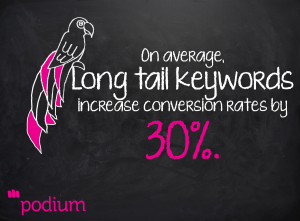Get on the Podium
Send us a message and let us know how we can help with your next project.
By Emma Thompson on 14 Jun 2017

Say you want to find the best interior designer in your area. Do you open a Google search tab and type in “interior designer Newcastle”? We’re guessing that you do.
Maybe you’ll find a couple of options, and then realise that you need someone who also knows how to do landscaping, and you can’t see anyone local that looks like they do both. So, the next search might be, “interior design and landscaping North East England.”
Is that better? Thought so.
This daily habit, explained, probably doesn’t sound like anything novel. However, have you considered this process while reviewing your marketing strategy?
Many people still think that if they search “their business name” and their website is the first result that comes up for them, they don’t need to improve their organic search rankings.
They’re forgetting that Google has tailored those results for them – oh, and the fact that people who don’t already know about their business are never going to search for the business’ name. Those customers just know that they want to find “interior design and landscaping North East England.”

So now you’re starting to understand what a long tail keyword is – a search team with three, four, five or even ten words which is very specific to the product or service the customer is searching for.
What do you sell and how is it described? What makes it stand out, or why would someone need it? Answer those questions, and you’ve found your long tail keywords.
The best part is, once your website matches those specific phrases, you’re set. Customers who already want to buy your product have come directly to you, and since you tick all the boxes, they’re likely to buy.
However, if you are the interior designer, who also does landscaping, and you’re located in the North East, but you only appear in organic search results for the keyword phrase ‘Sally Peppers Design,’ you might miss out.
Another case for long tail keywords is that they’ll help you stand out against the competition. There are loads of interior designers – but not necessarily ones that also provide landscaping services. Once your website is optimised with your USPs (unique selling points), the business will stand out and your target audience will be able to find you.
This is where a tactical search engine optimisation (SEO) strategy comes in very handy.
There are a number of important steps that you’ll need to take in order to rank for long tail search terms:
It’s essential to choose a list of keywords that people are actually searching for – if no one in the North East is Googling “interior design and landscaping” then there’s not much of a point in trying to rank for that phrase. But it’s likely that there are people searching for similar phrases, and the higher number of people searching for the phrase, the higher chance you have of being sought out. Choose a list of around ten phrases that match your business, have a high search volume, and preferably have low competition from other business.
The text on your website should feature the long tail keywords, but it shouldn’t be keyword stuffed. The keywords should be used to signal to Google that they are important, so place them in headlines and bold text when possible.
Tech-savvy marketers can optimise the back end of the website with meta titles, meta descriptions, and H1 tags. Learn more about how to improve your SEO in three simple steps.
Although it’s very important to set up the website correctly, that’s not usually enough. Google demands that you keep working toward page one rankings; it favours websites that constantly have new content added to their site, and punishes sites that don’t clean up spam and fix broken links. Ongoing SEO efforts will help to keep increasing rankings and making sure that your long tail keywords are working for your business.
For ongoing improvements, you’ll also want to blog about these topics and phrases, and include contextual keywords which help signal to Google that your content is quality, and not just trying to cheat the system.
It sounds like a lot of work, but once your target audience can finally find you, and sales start pouring in, it’s worth it. If you’d like a hand or some advice, drop us a line!
BackSend us a message and let us know how we can help with your next project.